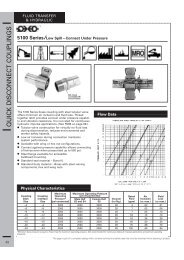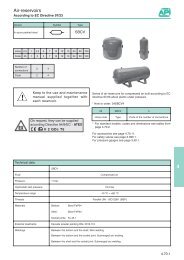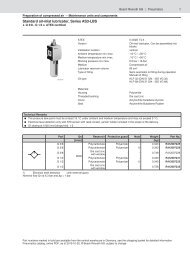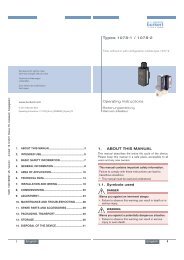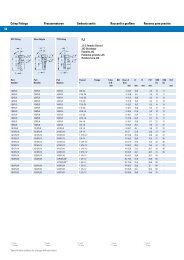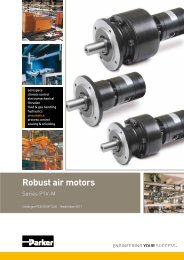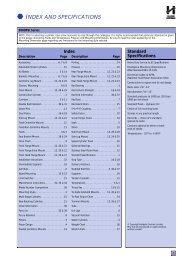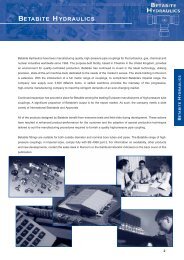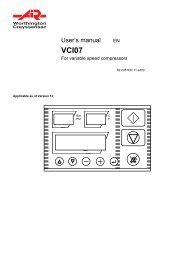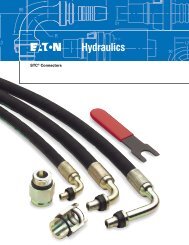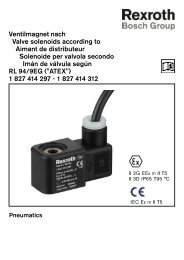P1DCylinderGuide for selecting suitable tubingThe selection of the correct size of tubing is often based on experience,with no great thought to optimizing energy efficiency andcylinder velocity. This is usually acceptable, but making a roughcalculation can result in worthwhile economic gains.The following is the basic principle:1. The primary line to the working valve could be over sized (thisdoes not cause any extra air consumption and consequentlydoes not create any extra costs in operation).2. The tubes between the valve and the cylinder should,however, be optimized according to the principle that aninsufficient bore throttles the flow and thus limits the <strong>cylinders</strong>peed, while an oversized pipe creates a dead volume whichincreases the air consumption and filling time.The chart below is intended to help when selecting the correctsize of tube to use between the valve and the cylinder.3 Ø12521Ø200Ø160Ø100Ø80Ø63Ø50Ø40Ø32Ø25Ø20Ø16Ø10CylinderØ [mm]1110987654321Equivalent throttling bore 1)The following prerequisites apply:The cylinder load should be about 50% of the theoreticalforce (= normal load). A lower load gives a higher velocityand vice versa. The tube size is selected as a function of thecylinder bore, the desired cylinder velocity and the tube lengthbetween the valve and the cylinder.If you want to use the capacity of the valve to its maximum,and obtain maximum speed, the tubing should be chosen sothat they at least correspond with the equivalent restrictiondiameter (see description below), so that the tubing doesnot restrict the total flow. This means that a short tubing musthave at least the equivalent restriction diameter. If the tubing islonger, choose it from the table below. Straight fittings shouldbe chosen for highest flow rates. (Elbow and banjo fittingscause restriction.)TubeØOut./ØInt.[mm]–/1214/110,2 0,5 0,8 1,1 1,4 0 1 2 3 4 5 6 7 8 9 10Cylinder speed [m/s]4Length of tubing [m]–/16–/15–/14–/1312/1010/88/66/45/34/2,7Air flowQn[Nl/min]40003800360034003200300028002600240022002000180016001400120010008004002001) The “equivalent throttling bore“ is a long throttle (for example a tube) or a series of throttles (for example, through a valve)converted to a short throttle which gives a corresponding flow rate. This should not be confused with the “orifice“ which issometimes specified for valves. The value for the orifice does not normally take account of the fact that the valve contains anumber of throttles.2) Qn is a measure of the valve flow capacity, with flow measured in litre per minute (l/min) at 6 bar(e) supply pressure and 1 barpressure drop across the valve.2006.05www.parker.com/euro_pneumatic
P1DExample 1 : Which tube diameter should be used?A 50 mm bore cylinder is to be operated at 0.5 m/s. Thetube length between the valve and cylinder is 2 m. In thediagram we follow the line from 50 mm bore to 0.5 m/s andget an “equivalent throttling bore“ of approximately 4 mm.We continue out to the right in the chart and intersect the linefor a 2 m tube between the curves for 4 mm (6/4 tube) and 6mm(8/6 tube). This means that a 6/4 tube throttles the velocitysomewhat, while an 8/6 tube is a little too large. We select the8/6 tube to obtain full cylinder velocity.Example 2 : What cylinder velocity will be obtained?A 80 mm bore cylinder will be used, connected by 8 m 12/10tube to a valve with Qn 1200 Nl/min. What cylinder velocity willwe get? We refer to the diagram and follow the line from 8 mmtube length up to the curve for 12/10 tube. From there, we gohorizontally to the curve for the Ø80 cylinder. We find that thevelocity will be about 0.5 m/s.Example 3 : What is the minimum inner diameter andmaximum lenght of tube?For a application a 125 mm bore cylinder will be used.Maximum velocity of piston rod is 0.5 m/s. The cylinder will becontrolled by a valve with Qn 3200 Nl/min. What diameter oftube can be used and what is maximum lenght of tube.We refer to the diagram. We start at the left side of the diagramcylinder Ø125. We follow the line until the intersection with thevelocity line of 0.5 m/s. From here we draw a horizontal line inthe diagram. This line shows us we need an equivalent throttlingbore of approximately 10 mm. Following this line horizontallywe cross a few intersections. These intersections showsus the minimum inner diameter (rightside diagram) in combinationwith the maximum length of tube (bottomside diagram).For example:Intersection one: When a tube (14/11) will be used,the maximum length of tube is 0.7 meter.Intersection two: When a tube (—/13) will be used,the maximum length of tube is 3.7 meter.Intersection three: When a tube (—/14) will be used,the maximum length of tube is 6 meter.CylinderValve series with respective flows in Nl/minuteValve seriesQn in Nl/MinValvetronic Solstar 33Interface PS1 100Valvetronic Interface 2000 100B2 Series 168Adex A05 173Moduflex size 1, (2 x 3/2) 220Valvetronic PVL-B 5/3 closed centre, 6 mm push in 290Moduflex size 1, (4/2) 320B43 Manual and mechanical 340Valvetronic PVL-B 2 x 2/3, 6 mm push in 350Valvetronic PVL-B 5/3 closed centre, G1/8 370Compact Isomax DX02 385Valvetronic PVL-B 2 x 3/2 G1/8 440Valvetronic PVL-B 5/2, 6 mm push in 450Valvetronic PVL-B 5/3 vented centre, 6 mm push in 450Moduflex size 2, (2 x 3/2) 450Flowstar P2V-A 520Valvetronic PVL-B 5/3 vented centre, G1/8 540Valvetronic PVL-B 5/2, G1/8 540Valvetronic PVL-C 2 x 3/2, 8 mm push in 540Adex A12 560Valvetronic PVL-C 2 x 3/2 G1/8 570Compact Isomax DX01 585Valvetronic PVL-C 5/3 closed centre, 8 mm push in 700Valvetronic PVL-C 5/3 vented centre, G1/4 700VIKING P2L-A 760B3 Series 780Valvetronic PVL-C 5/3 closed centre, G1/4 780Moduflex size 2, (4/2) 800Valvetronic PVL-C 5/2, 8 mm push in 840Valvetronic PVL-C 5/3 vented centre, 8 mm push in 840Valvetronic PVL-C 5/2, G1/4 840VIKING P2L-B 1020Flowstar P2V-B 1090ISOMAX DX1 1150B53 Manual and mechanical 1160B4 Series 1170Airline Isolator Valve VE22/23 1470ISOMAX DX2 2330VIKING P2L-D 2880ISOMAX DX3 4050Airline Isolator Valve VE42/43 5520Airline Isolator Valve VE82/83 13680Example 4 : Determining tube size and cylindervelocity with a particular cylinder and valve?For an application using a 40 mm bore cylinder with a valvewith Qn=800 Nl/min. The distance between the cylinder andvalve has been set to 5 m.Tube dimension: What tube bore should be selected to obtainthe maximum cylinder velocity? Start at pipe length 5 m, followthe line up to the intersection with 800 Nl/min. Select the nextlargest tube diameter, in this case Ø10/8 mm.Cylinder velocity: What maximum cylinder velocity will beobtained? Follow the line for 800 Nl/min to the left until it intersectswith the line for the Ø40 mm cylinder. In this example, thespeed is just above 1.1 m/s.2106.05www.parker.com/euro_pneumatic



